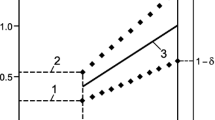A method of increasing the accuracy of triaxial magnetometers using distorting (correcting) matrices is proposed. A noise-immune method of determining such matrices using a standard measure of magnetic induction, and also an accurate and operative method of determining the nonorthogonalities of a magnetometer and a method of determining the orientation of a (nonorthogonal) magnetometer in a (nonorthogonal) measure are developed. Particular attention is paid to the analogy of a distorting matrix to the well-known system of Poisson parameters.


Similar content being viewed by others
Notes
In the original paper [4], it is called the intrinsic reference frame system (IRFS).
Two types of fluxgate magnetometers are used at the present time: with spaced and coincident centers of the components. It is stated in [4, 6] that each type has its own form of magnetic axes, while in [7] they assert that both forms of axes are appropriate to both types of magnetometers. It is shown in (1)–(4) that a change in the form of the axes is independent of the type of magnetometer, but is related to the form of Eq. (1) or (3), which are applicable to both types of magnetometers.
In [8, 10, 11], expressions (19) and (20) are sometimes misrepresented and sometimes identified. At one point, in [10, 11], it would seem that (19) and (20) contradict one another. However, as follows from (18), there is no contradiction, since both expressions are correct. The point is that they correspond to two different triples of the axes I i and h i (see (2) and (4)).
References
V. G. Semenov, Two Histories of Ship Demagnetization [in Russian], Dialog, St. Petersburg (2008).
Yu. M. Ivanov and V. G. Semenov, Patent 2229727 RF, “A method of determining the correcting matrix of a threecomponent magnetometer,” Izobret. Polezn. Modeli, No. 15 (2004).
Yu. M. Ivanov and V. G. Semenov, Patent 2262711 RF, “A method of determining the calibration matrix of a threecomponent magnetometer (versions),” Izobret. Polezn. Modeli, No. 29 (2005).
J. M. Merrayo et al., “Scalar calibration of vector magnetometers,” Meas. Sci. Technol., 11, 120–132 (2000).
V. G. Semenov, “Comment on ‘Scalar calibration of vector magnetometers’,” Meas. Sci. Technol., 14, 235–237 (2003).
J. M. J. Merrayo et al., “Reply to Comment on ‘Scalar calibration of vector magnetometers’ by V. G. Semenov,” ibid., 238.
J. M. J. Merrayo et al., “The orthogonalization of magnetic systems,” Sensors and Actuators, A89, 185–196 (2001).
Yu. V. Afanasiev, Fluxgate Devices [in Russian], Energoatomizdat, Leningrad (1986).
V. Ya. Shifrin, The Development and Investigation of Standard Instruments for Measuring Weak Magnetic Induction: Candid. Dissert., Leningrad (1972).
A. V. Zaitsev et al., “Determination of the orthogonality of three-component magnetometer converters,” Metrologiya, No. 9, 51–56 (1980).
G. A. Vnuchkov et al., “Angular errors of measurements of magnetic induction,” in: Methods and Instruments for Investigating the Structure of the Geomagnetic Field [in Russian], edited by N. M. Rotanova, IZMIRAN, Moscow (1989).
I. N. Terekhov, Degaussing and the Deviation of Compasses [in Russian], Morskoi Transport, Moscow (1945).
V. G. Semenov, “Synthesis of spherical methods of determining magnetic field source parameters of internal and external origin,” Izmer. Tekhn., No. 12, 35–37 (1990); Measur. Techn., 33, No. 12, 1236–1240 (1990).
K. K. Barakhnin et al., “Investigation of a quantum autocompensator of the variations of the Earth’s magnetic field,” Trudy Metrolog. Inst. SSSR, Iss. 215 (275), 24–26 (1976).
Yu. M. Ivanov and V. G. Semenov, Patent 2394251 RF, “A method of determining external interference at the center of a magnetic induction measure,” Izobret.. Polezn. Modeli, No. 10 (2009).
A. V. Zaitsev and V. G. Semenov, “The temperature error of a ferromodulation magnetomeasuring apparatus,” Metrologiya, No. 12, 49–56 (1977).
Author information
Authors and Affiliations
Corresponding author
Additional information
Translated from Izmeritel’naya Tekhnika, No. 6, pp. 46–51, June, 2013.
Rights and permissions
About this article
Cite this article
Ivanov, Y.M., Semenov, V.G. Correcting matrices – a way of increasing the accuracy of triaxial magnetometers. Meas Tech 56, 674–682 (2013). https://doi.org/10.1007/s11018-013-0264-4
Received:
Published:
Issue Date:
DOI: https://doi.org/10.1007/s11018-013-0264-4




